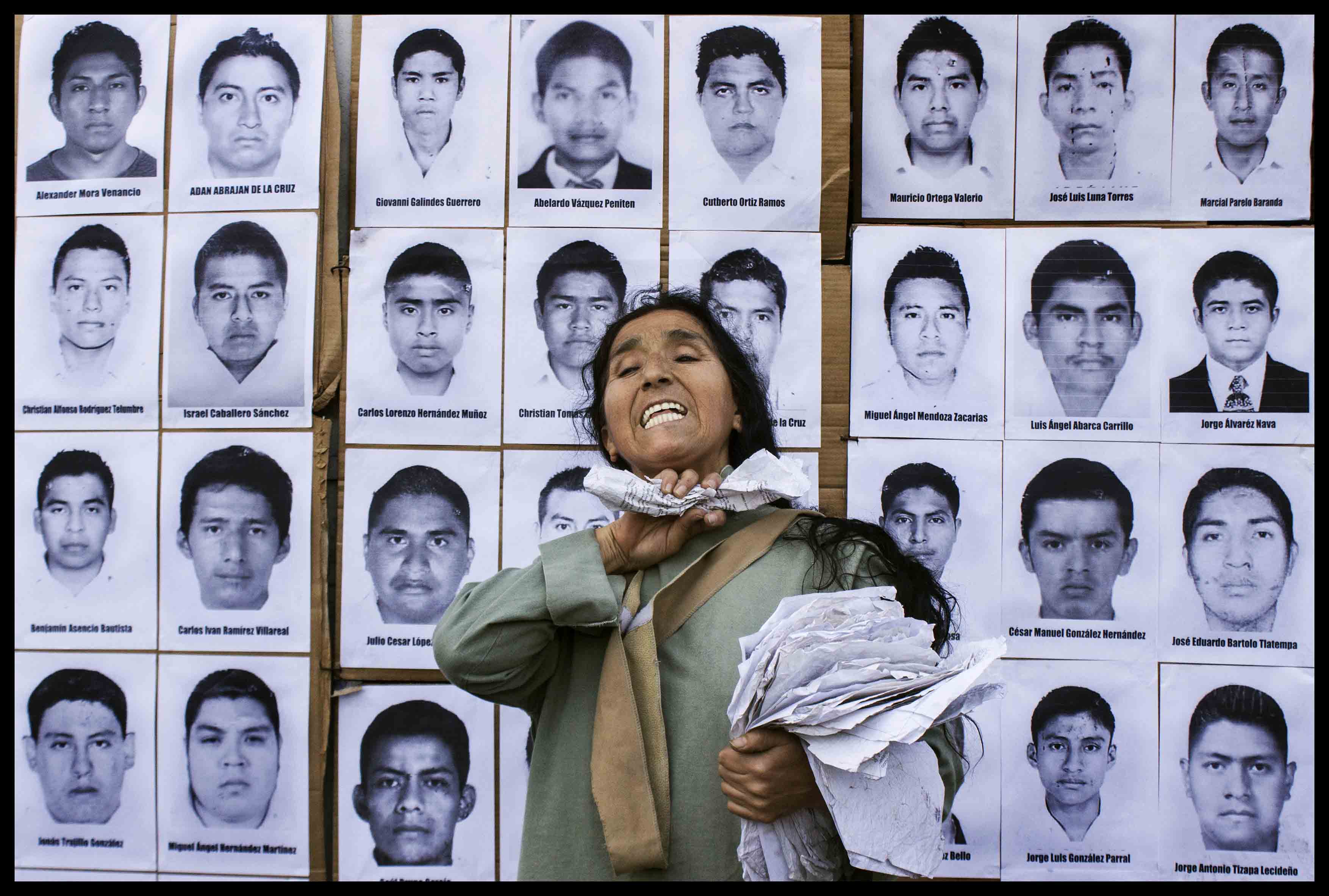During this past year, Mexico experienced one of the worst crimes in recent memory — the kidnap and murder of almost 50 students. The magnitude of this atrocity has not been seen in the country since the Tlatelolco Massacre, which occurred on October 2, 1968. Over 500 students were wounded and killed by the police, under orders of then-President Gustavo Díaz Ordaz. Both of these tragic events are a manifestation of something much larger within the Mexican state. The outsized influence of powerful elitist groups in Mexican politics has undermined democracy in Mexico. The degradation of democracy led to the normalization of both the student kidnappings and the the events that followed.
This past September, 43 students from a teachers college in the small town of Ayotzinapa went missing. What began with students heading to the capitol to protest the education reform bill, ended in a series of events that exposed many of the problems that Mexico is facing. The Mexican authorities, in an attempt to find the missing people, uncovered a set of mass graves near the state of Guerrero — where Ayotzinapa is located. However, these mass graves did not contain the bodies of the missing students.[1] The investigation of the grave led to the discovery that the mayor of one of the municipalities in Guerrero, Jose Luis Abarca, along with his wife, were involved with the drug cartels in the area.[2] The couple was responsible for ordering the police to stop the protests over the education reform bill. The students were allegedly kidnapped and transferred to a local drug gang named Guerreros Unidos, who in turn murdered every student in cold blood. Additional investigations were made by the Procuraduría General de La República (PGR) or the Mexican Attorney General’s office. The head of this agency, Jesús Murillo Karam, reported that the students’ bodies were burnt in Cocula, a nearby dump. Most human remains found were completely incinerated, preventing the Argentine forensics experts working with the PGR from recovering traces of DNA. Scientists were able to recover a few DNA samples from a molar and two centimeters of bone fragment, and sent them to a specialized lab at the University of Innsbruck, in Austria. The recovered DNA traced back to one of the students.[3] However, the credibility of the Mexican government and its investigators has been questioned, and the families of the other forty-two students are determined to keep up the search.
However, the problem is that the prevailing narrative of that September day is flawed; nobody really knows what happened, every version of the story is different. While some sources like the BBC claim that the students were protesting discriminatory hiring practices for teachers[4] others, like the independent Reflections on a Revolution Magazine, claim that the students came from a school program with the goal of social emancipation of the poor.[5] In each media narrative, there is no clear account of what happened or who was responsible.
It appears that no one in Mexico wants to tell the truth about what happened, because nobody is willing to assume the responsibility. One noticeable characteristic of the mass kidnapping event is the unwillingness of any Mexican authority to assign blame. Doing so could also implicate local authorities and their involvement in the event. This dynamic has led to a pseudo-friendship between opposing political parties and different members of Mexico’s government. These various parties have partnered to create a master narrative that implicates the most obvious culprits, the drug gangs, while eschewing government culpability. Such collusion is inherently undemocratic: not a single opposing political party has taken the lead in demanding government accountability. It appears that Mexican political parties fear that elements within their own organizations may be involved in the kidnappings, or other similar events. However, by shifting the responsibility to the drug gangs, those in power easily escape scrutiny and accountability.
This dynamic within the government is a side effect of a bigger issue: the erosion of democracy by powerful elitist groups in Mexican politics. Their influence has manifested in the recent and historical violence in Mexico. The elite groups in Mexico can be categorized into three mutually-reinforcing political actors. The first group is comprised of corrupt politicians. Widespread corruption and lack of accountability in the government has allowed these elite groups to get away with almost anything. Because there are no mechanisms to keep them in check, they exercise their power at their own whim. Many political leaders have strong ties to the drug cartels in and out of the country. One clear example is the wife of Mayor Jose Luis Abarca, who is related to members of the Beltrán Leyva and Guerreros Unidos drug gangs.[6] This drug gang was responsible for murdering the 43 college students after their encounter with the police.
The second group is comprised of drug cartels and their militant enforcers. The presence of militant groups and drug cartels in the country has a tremendous influence over the government at every level. The amount of power and wealth the cartels have obtained through their operations has given them the ability to manage their illicit businesses without worrying about government repercussions. These cartels can control government officials through bribes, violence and coercion — using threats to their person and families.
There is a third group that has played a crucial role in the erosion of democracy in Mexico. The billionaire elites that control many of the industries in the country have shaped economic, political and social relationships. As opposed to other elitist groups in the country, this group’s main source of income comes from licit activities in Mexico and elsewhere. These individuals have gained so much economic power that their combined income represents a large portion of the Mexican GDP. One of the clearest examples is Carlos Slim, with a personal wealth of $79.6 billion,[7] he represents 4.3% of Mexico’s GDP.[8] With this amount of wealth comes political power — the elite have the capability of influencing policymaking and policy enforcement. The disproportionate power held by each of these three groups has lead to a slow decay of democratic institutions, and the demise of the middle class and civil society. Typically, when the role of civil society in governance diminishes, the less accountable a country’s leaders become. This leads to a collapse in democratic processes, where ordinary citizens have little or no say in the way their country is being run. With less accountability to citizens, corruption and violence increase dramatically, and the state fails to provide basic services for its citizens. In Mexico, this vacuum of social service provision provides an opportunity for drug gangs to offer a supposed way out of poverty for the oppressed lower class.
The impoverishment of the Mexican lower class is a product of the decay of the middle class and the polarization between the rich and the poor. As the income gap widens, small groups of elites have gained enough money and power to control the country completely, while the lower class becomes frustrated and angry. This frustration manifests in the recent protests and riots seen in the country, including the education reform bill protests the kidnapped students were travelling to. In the absence of economic growth in the middle class, many Mexicans may pursue illegal or illegitimate activities to enhance their livelihoods. This reinforces the power held by elite groups, in a cruel cycle of poverty and violence.
The Mexican government continues to look for “those responsible” for crimes like the mass kidnapping instead of tackling underlying problems including, inefficient institutions, corruption, and lack of government transparency. President Enrique Peña Nieto has called upon the Mexican community to join in a collaborative effort to move forward to overcome this moment of pain.[9] However, instead of looking for a way to alleviate the underlying popular grievances, the government looks for a scapegoat to sweep such problems under the rug.
For 70 years, Mexico was run by the Partido Revolucionario Institucional (PRI). The PRI administration was marked by hierarchy and political favors, and created a system where government officials acted according to self-interest without addressing issues concerning the larger Mexican population. In 2000, when the Partido Acción Nacional (PAN) finally overthrew the PRI, nothing really changed. The new administration tried to disassociate itself from the PRI officials still inside the government, but instead of working to change the way government ran, PAN officials made no meaningful progress in dismantling the corrupt PRI infrastructure. When the PRI was voted back into office with Enrique Peña Nieto in 2012, the system continued to operate as it always had, as if no change in power had ever occurred.
In the Mexican political system, incumbents are averse to change, preferring to maintain the status quo out of purely self-interested power politics. Furthermore, due to the fact that elite institutions in Mexico are so tightly linked, even a few individuals who aspire to change the system are easily eliminated through murder, falsified legal charges, or arbitrary restrictions on labor mobility.
In the case of Ayotzinapa, the government has tried to “move forward” but the Mexican people are not willing to forget the killings, the disappearances and the pursuit for answers. As government officials try to convince the public that the prevailing narrative is the truth, many citizens are unsatisfied and it is clear that much bigger issues are at stake. The kidnappings demonstrate the ongoing cycle of violence, oppression and inefficiency in Mexico. Although events like the Tlatelolco massacre appeared to be a thing of the past, the events of September 2014 proved otherwise. Ayotzinapa represents so much more than just 43 missing students, it is one of the symptoms of a decaying democracy in a country that has so much potential to thrive. The missing students are symbolic of the thousands of people that have gone missing in Mexico. The government is responsible for investigating all cases of missing persons, not just the students of Ayotzinapa. The mass kidnapping simply brought international attention to the issue of Mexican corruption. The spotlight shined by the international community has forced the Mexican government to assume at least some responsibility, although so far they have fallen into the same cycle of blame that has plagued Mexican politics for generations.
A system that only works for elites will remain operational until there is a substantial internal or external shock. It may be shortsighted of elites in Mexico to believe they can continue controlling the country as they always have. Mexico is approaching an important moment in modern history. Ayotzinapa should be a wake up for Mexican people and elites alike, to begin to strengthen government institutions and promote transparency and accountability. Only such actions will bring checks and balances to the elites that have led Mexico to the edge of a cliff.
[1] Ayotzinapa: A Timeline of the Mass Disappearance That Has Shaken Mexico , last modified December 9 2014, https://news.vice.com/article/ayotzinapa-a-timeline-of-the-mass-disappearance-that-has-shaken-mexico
[2]“Los Abarca-Pineda, una historia de impunidad”, last modified November 4th 2014, http://noticieros.televisa.com/mexico/1410/quienes-son-jose-luis-abarca-velazquez-maria-angeles-pineda/
[3] Crisis in Mexico: Who Is Really Responsible for the Missing Forty-three?, last modified February 7, 2015, http://www.newyorker.com/news/news-desk/crisis-mexico-really-responsible-missing-forty-three
[4] Mexican students missing after protest in Iguala, last modified on September 29, 2014, http://www.bbc.com/news/world-latin-america-29406630
[5] Ayotzinapa protests awaken Mexico from a nightmare, last modified November 7, 2014, http://roarmag.org/2014/11/ayotzinapa-mexico-students-disappearances/
[6] Mexico’s ‘First Lady of murder’ caught in squalid bolt hole: Mayor and wife accused of using drug cartel to kill 43 protesting students who threatened to disrupt party and speech are finally captured, last modified November 4, 2013, http://www.dailymail.co.uk/news/article-2820352/Mexican-mayor-captured-going-run-disappearance-43-students-wife-ordered-police-stop-interrupting-speech.html
[7]Mexico’s Carlos Slim Reclaims World’s Richest Man Title From Bill Gates, last modified July 15, 2015, http://www.forbes.com/sites/doliaestevez/2014/07/15/mexicos-carlos-slim-reclaims-worlds-richest-man-title-from-bill-gates/
[8] World Factbook: Mexico, last modified June 20, 2014, https://www.cia.gov/library/publications/the-world-factbook/geos/mx.html
[9] Peña Nieto llama a “superar” el dolor del caso Ayotzinapa, last modified December 5, 2014, http://mexico.cnn.com/nacional/2014/12/04/pena-nieto-guerrero-visita-plan-seguridad-ayotzinapa-43-normalistas



